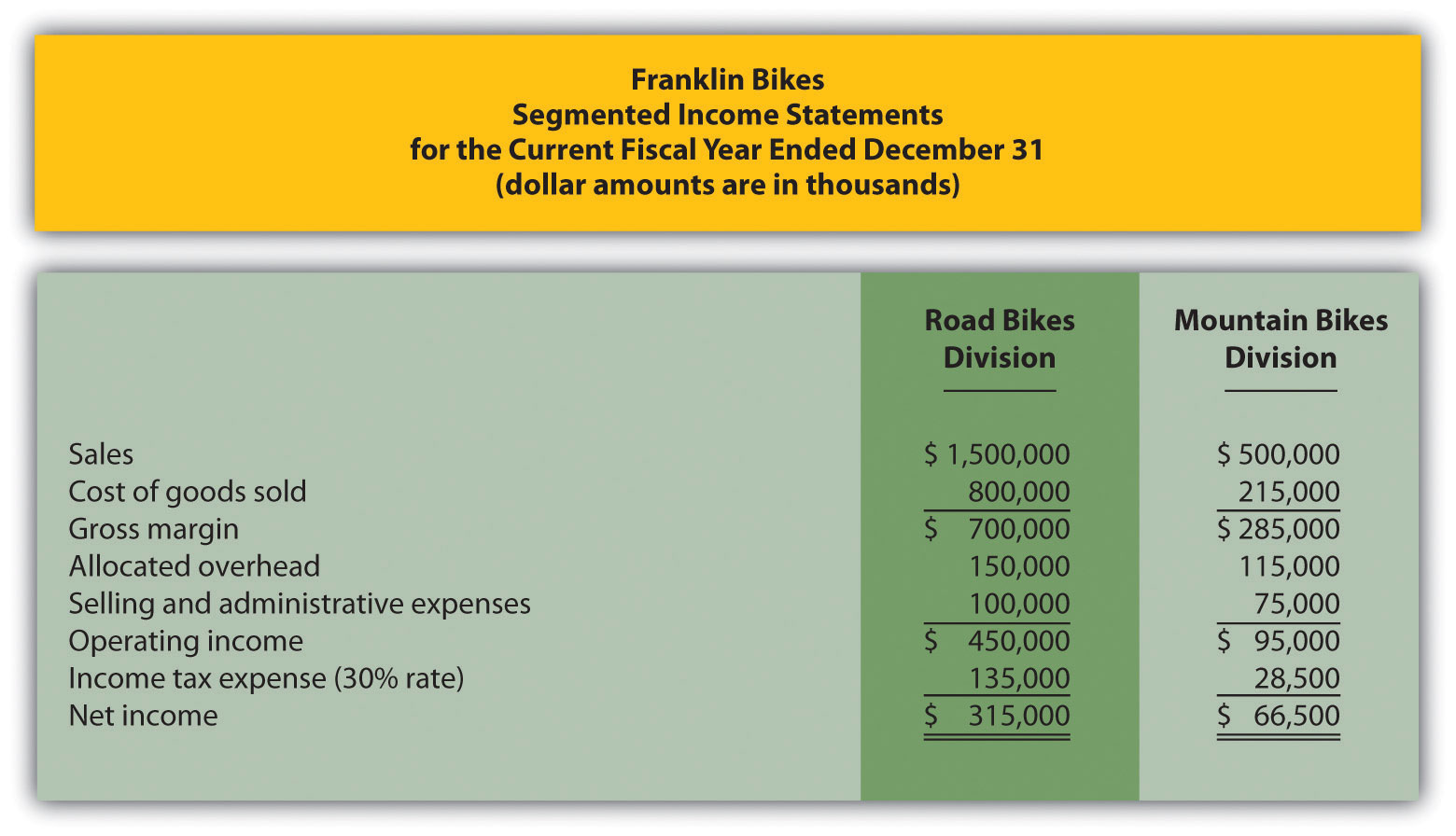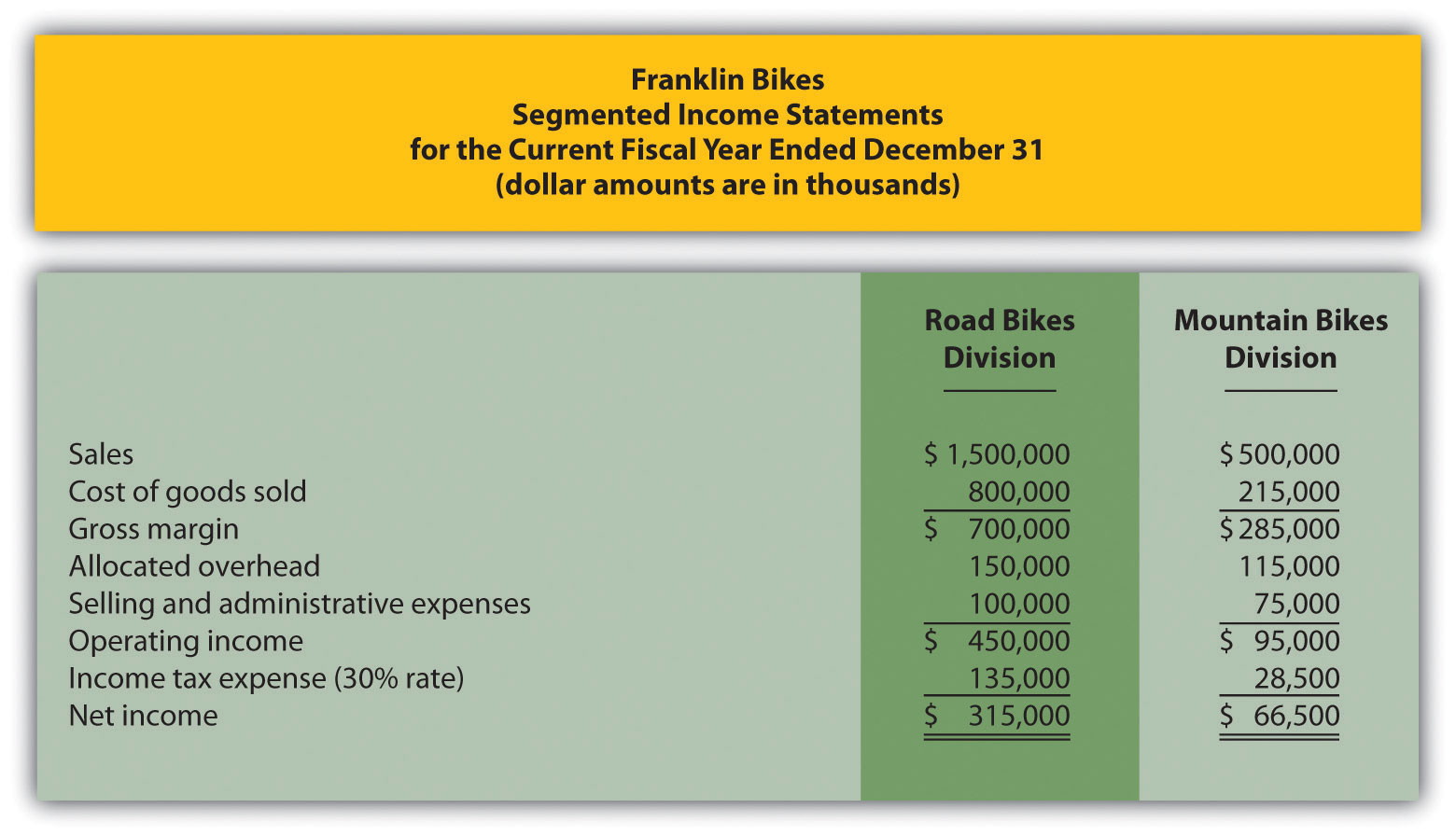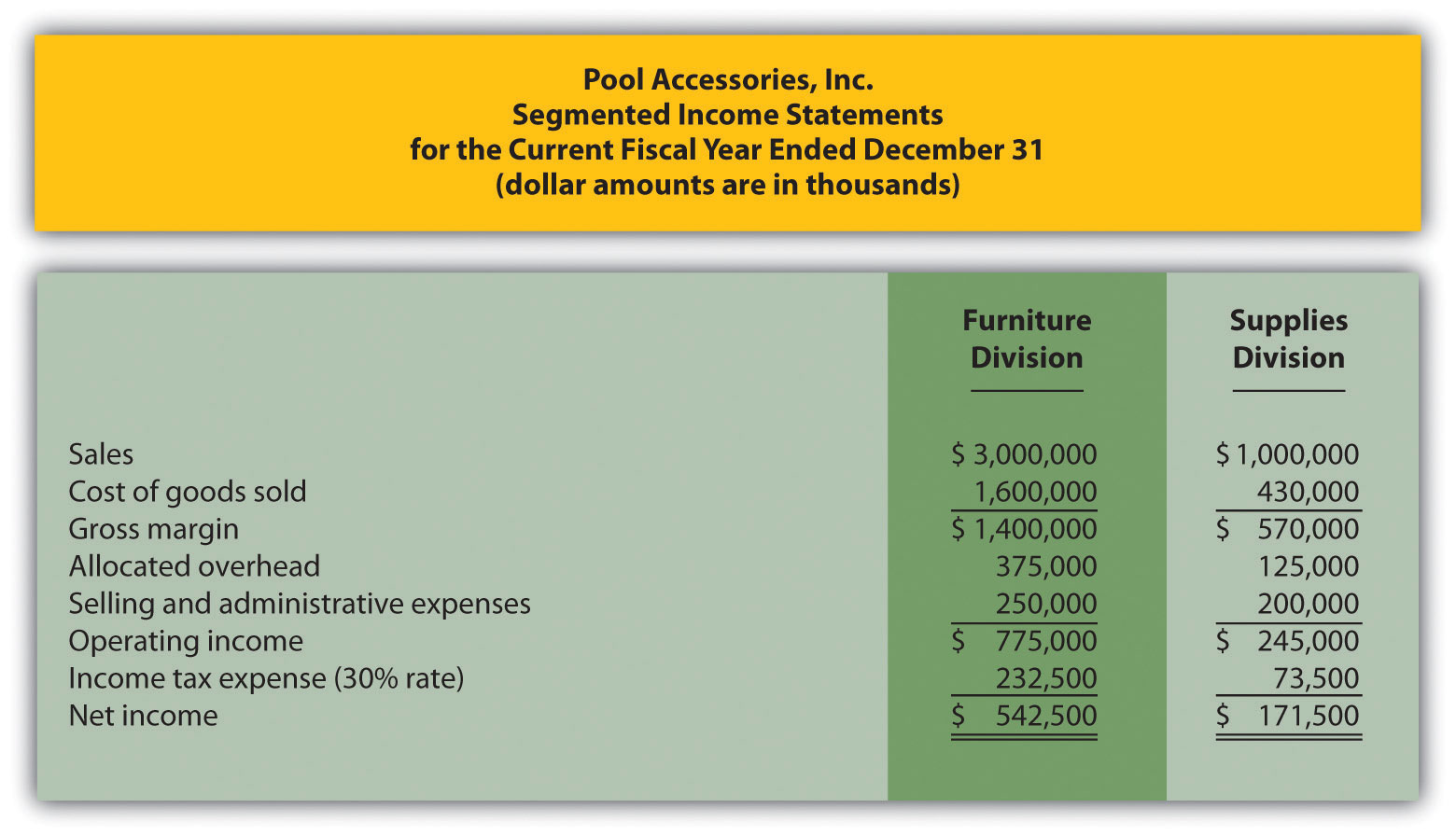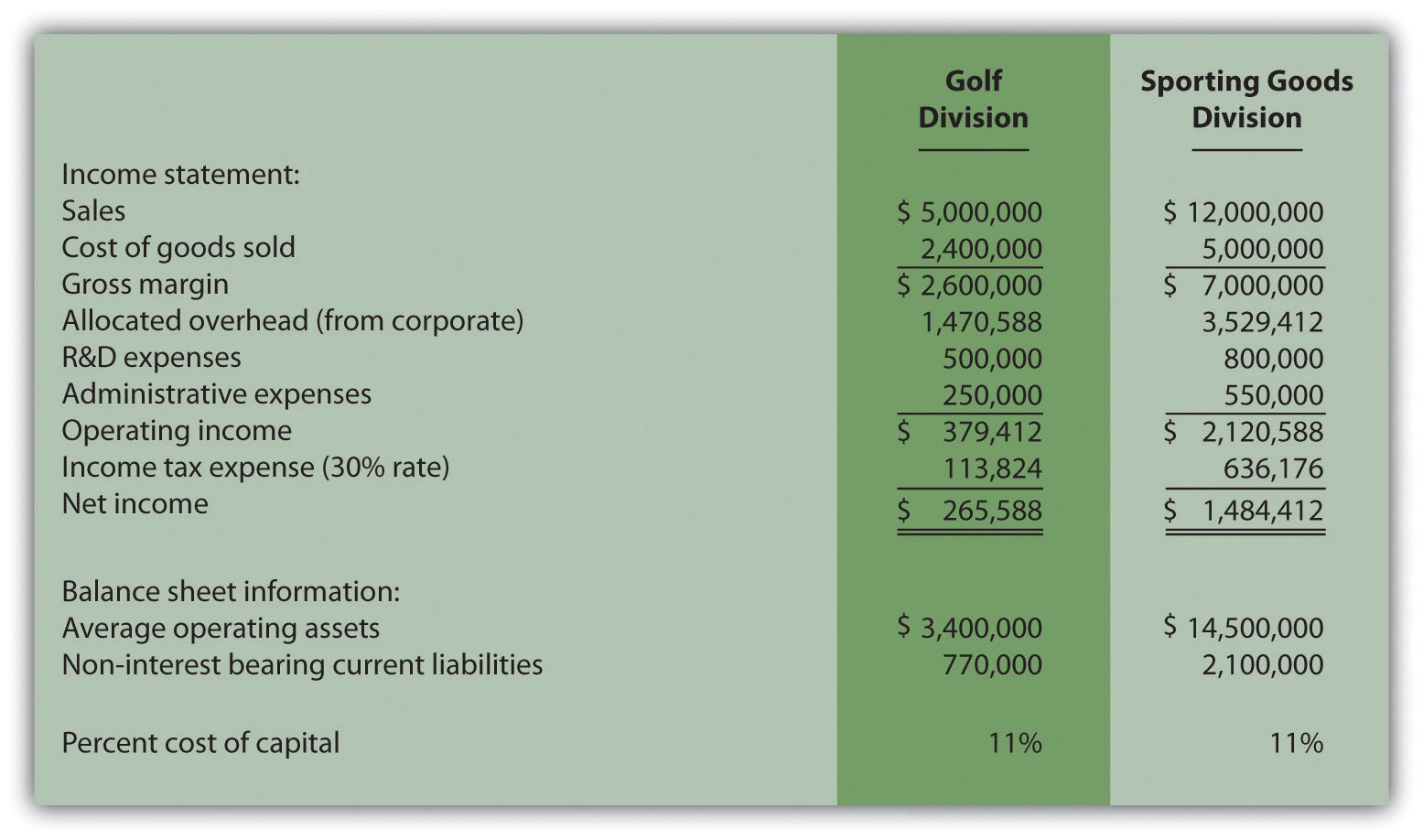11.E: Exercises (part 1)
- Page ID
- 27357
Questions
- What is meant by the term decentralized organization?
- What are the advantages and disadvantages of decentralizing operations?
- Refer to Note 11.3 "Business in Action 11.1" Why would a growing college, such as Sierra College, decentralize operations?
- Refer to Note 11.4 "Business in Action 11.2" How did decentralization at Arthur Andersen contribute to the company’s downfall?
- Describe the three types of responsibility centers presented in the chapter.
- Describe at least three measures used to evaluate performance of investment center division managers.
- What are the two weaknesses of using segmented net income to evaluate managers of investment centers? What performance measures would you use to overcome these weaknesses?
- What is the primary advantage of using ROI rather than segmented net income or profit margin ratio to evaluate investment center managers?
- Describe operating profit margin and asset turnover, and explain how each of these ratios can be used to help division managers improve ROI.
- Describe the potential conflict that can occur between division manager goals and overall company goals when evaluating divisions using ROI.
- Refer to Note 11.25 "Business in Action 11.4" How did General Electric modify net income to evaluate each segment?
- Describe residual income (RI), and explain how RI can resolve the conflict between division manager goals and company goals often created by using ROI.
- Explain the difference between RI and economic value added.
- Refer to the Game Products, Inc., performance measures presented in Figure 11.11. Identify which measures you would recommend to the CEO of Game Products, and explain the reasoning behind your recommendation.
- Appendix. Describe the general economic transfer pricing rule.
Brief Exercises
- Evaluating Division Managers at Game Products, Inc. Refer to the dialogue at Game Products, Inc., presented at the beginning of the chapter. Why does the president want to give Carla Klesko, the Board Games division manager, a bonus? Does the CFO agree that Carla deserves a larger bonus than the other division managers? What performance measures would the CFO like to consider before awarding Carla a larger bonus?
- Decentralizing Operations. Burton Electronics produces radios, computers, and navigation systems. Although all high level decisions are made at company headquarters by top management, rapid expansion and increasingly specialized products have caused the company to consider decentralizing into three divisions. Each division manager would be responsible for costs, revenues, and investments in assets.
Required:
- How should the company classify each division, as a cost center, profit center, or investment center? Explain.
- What are the potential advantages of decentralizing?
- What are the potential disadvantages of decentralizing?
- Responsibility Centers. Aviation Products, Inc., operates primarily in the United States and has several segments:
- Accounting and finance: responsible for recording financial information and preparing financial reports.
- Human resources: responsible for hiring employees and maintaining personnel records.
- Retail stores: responsible for sales prices and all costs within each store.
- Advertising: responsible for promotional materials.
- Production: responsible for manufacturing company products.
- International operations: acts as an independent segment responsible for all facets of the business outside of the United States.
Required:
For each of the preceding segments, identify whether it is a cost center, profit center, or investment center. Explain your answer.
- Segmented Net Income. Franklin Bikes has two divisions—Road Bikes and Mountain Bikes. Using the segmented income statements presented in the following, determine the profit margin ratio for each division.

- Return on Investment (ROI). The segmented income statements presented as follows are for the two divisions of Franklin Bikes. (This is the same company as the previous exercise. This exercise can be assigned independently.) Assume the Road Bikes division had average operating assets totaling $4,500,000 for the year, and the Mountain Bikes division had average operating assets of $800,000. Calculate ROI for each division.

- Residual Income (RI). The segmented income statements presented as follows are for the two divisions of Franklin Bikes. (This is the same company as the previous exercises. This exercise can be assigned independently.) Assume the Road Bikes division had average operating assets totaling $4,500,000 for the year, and the Mountain Bikes division had average operating assets of $800,000. The company’s cost of capital rate is 8 percent. Calculate RI for each division.

- Economic Value Added (EVA). Computer Tech Company has two divisions—Hardware and Software. Adjustments have already been made to net operating profit after taxes (NOPAT) and average operating assets for the purposes of calculating EVA for each division. This adjusted information is shown as follows. Assume the company’s cost of capital is 12 percent. Calculate EVA for each division.
Hardware Division Software Division NOPAT—adjusted $ 810,000 $ 980,000 Average operating assets—adjusted 3,500,000 3,200,000 - (Appendix). What is the primary goal for an organization establishing a transfer pricing policy?
Exercises: Set A
- Segmented Net Income. Pool Accessories, Inc., has two divisions—Furniture and Supplies. The following segmented financial information is for the most recent fiscal year ended December 31.
Furniture Division Supplies Division Sales $3,000,000 $1,000,000 Cost of goods sold 1,600,000 430,000 Allocated overhead 375,000 125,000 Selling and administrative expenses 250,000 200,000 Assume the tax rate is 30 percent.
Required:
- Prepare a segmented income statement using the format presented in Figure 11.3. Include the profit margin ratio for each division at the bottom of the segmented income statement.
- Using net income as the measure, which division is most profitable? Explain why this conclusion might be misleading.
- What does the profit margin ratio tell us about each division? Why do organizations often use profit margin ratio to evaluate division performance rather than simply using net income?
- ROI. Pool Accessories, Inc., has two divisions—Furniture and Supplies. (This is the same company as the previous exercise. This exercise can be assigned independently.) Segmented income statement information for the most recent fiscal year ended December 31 is shown as follows. Assume the Furniture division had average operating assets totaling $6,500,000 for the year, and the Supplies division had average operating assets of $1,750,000.

Required:
- Calculate ROI for each division.
- What does ROI tell us about each division? Indicate why this measure is useful in evaluating investment centers.
- ROI Using Operating Profit Margin and Asset Turnover. Pool Accessories, Inc., has two divisions—Furniture and Supplies. (This is the same company as the previous exercises. This exercise can be assigned independently.) Segmented income statement information for the most recent fiscal year ended December 31 is shown as follows. Assume the Furniture division had average operating assets totaling $6,500,000 for the year, and the Supplies division had average operating assets of $1,750,000.

Required:
- For each division, calculate operating profit margin, asset turnover, and resulting ROI.
- Which division has the highest ROI? For the division that has the lowest ROI, what can be done to improve this ratio?
- RI. Pool Accessories, Inc., has two divisions—Furniture and Supplies. (This is the same company as the previous exercises. This exercise can be assigned independently.) Segmented income statement information for the most recent fiscal year ended December 31 is shown as follows. Assume the Furniture division had average operating assets totaling $6,500,000 for the year, and the Supplies division had average operating assets of $1,750,000. Assume the cost of capital rate is 10 percent.

Required:
- Calculate RI for each division.
- What does RI tell us about each division?
- Solving Unknowns for ROI. The following information is for two divisions at Kayak Company.
Lake Division Ocean Division Sales ? $900,000 Operating income ? $108,000 Operating profit margin 8.0 percent ? Average operating assets $150,000 $600,000 Asset turnover 1.7 ? ROI ? ? Required:
Find the missing information for each division.
- EVA. Links Company produces golf clubs and other sporting goods accessories. The following information is for each division at Links for the most recent fiscal year.

To calculate EVA, the management requires adjustments for R&D and noninterest bearing current liabilities as outlined in the following.
Research and development will be capitalized and amortized over several years resulting in an increase to average operating assets of $400,000 for the Golf division and $650,000 for the Sporting Goods division. On the income statement, R&D expense for the year will be added back to operating income; then R&D amortization expense for one year will be deducted. The current year amortization expense will total $100,000 for the Golf division and $150,000 for the Sporting Goods division.
Noninterest bearing liabilities will be deducted from average operating assets.
Required:
Calculate EVA for each division and comment on your results.
- (Appendix) Transfer Pricing. Creative Colors, Inc., a producer of paint, has two divisions—Paint division and Can division. Each division manager is evaluated based on profit produced by each division.
The Can division sells its cans to the Paint division for $2 per case to cover variable costs. The Can division also sells to outside customers for $3 per case.
Required:
- Using the general economic transfer pricing rule, calculate the optimal transfer price assuming the Can division is below capacity.
- Using the general economic transfer pricing rule, calculate the optimal transfer price assuming the Can division is at capacity.

